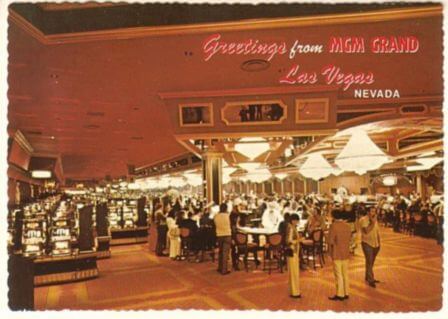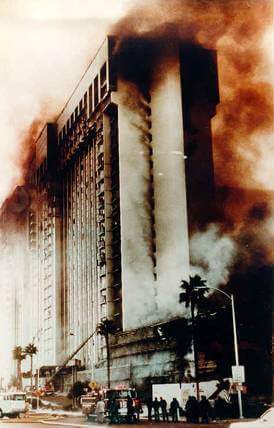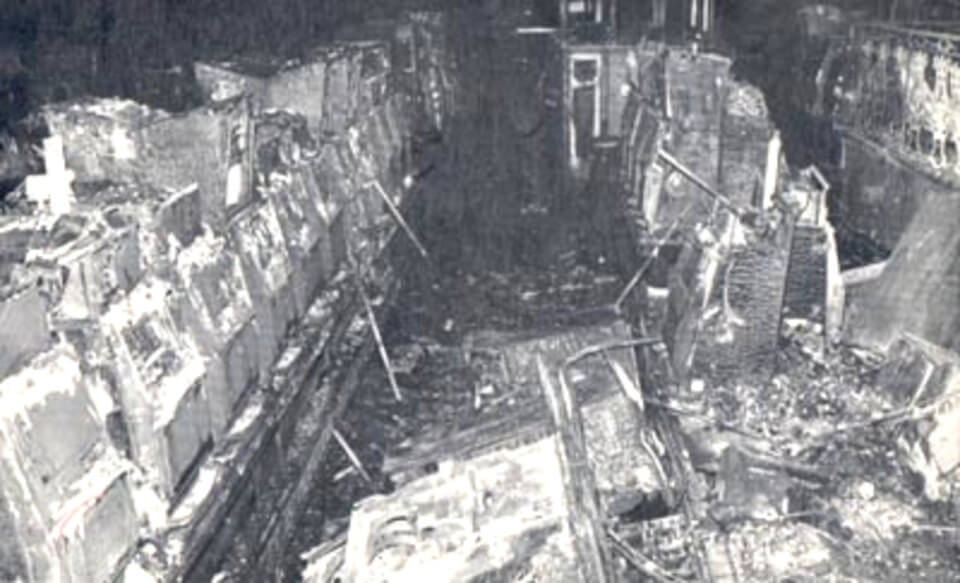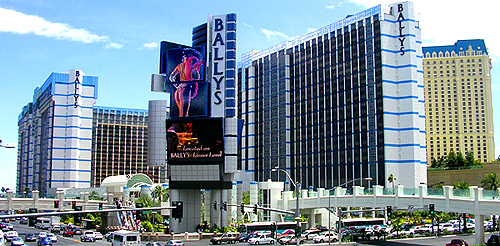The Bally’s / MGM Grand Fire of 1980
In the heart of the bustling Las Vegas strip, dire tragedy once struck. The MGM Grand fire of November 21, 1980 was the second largest loss-of-life hotel fire in the history of the United States, and the deadliest event in Nevada state history. Because of the raging fire and severe smoke from the blaze, 87 people died, and over 700 were injured in the 26-story building.
At the time of the fire, approximately 5,000 guests and staff occupied the hotel, leaving many to live to tell the story of this accidental, yet avoidable, disaster.
Before the Fire
The MGM Grand Hotel was one of the earliest luxury mega-hotels on the Strip, with a price tag of $106 million.
At its opening in 1973, it was the largest hotel in the world. Though we may think of the modern-day MGM Grand Hotel and Casino when we hear “MGM Grand,” the MGM Grand Hotel fire actually took place on the site of what is now the Bally’s Hotel and Casino.

The Start of the Fire
This calamitous fire started in the Deli, an upscale restaurant on the casino floor, due to a number of electrical issues that took place that morning. The Deli was not sprinklered, and there were no heat or smoke detectors installed. After a failed attempt by one employee to contain the fire, witnesses contacted emergency services.
As soon as Captain Rex Smith and his fire crew from the Clark County Fire Department arrived, they noticed the eerie sight of “heavy black smoke lying motionless in the atmosphere” above the casino pit.
A Rapid Spread
The crew looked toward the Deli. A fireball exploded from the restaurant area, hurtling into the casino. Immediately, the crew began to evacuate the hotel, as the heavy, deadly smoke descended upon them.
During the fire, no alarms rang, as there was no automatic fire alarm system in place. The only alarm system the MGM did have was purely for security purposes. Making matters worse, the building was only sprinklered in certain areas, as sprinklers weren’t installed throughout the hotel.
The fire was able to spread so quickly due, in no small part, to the decor of the posh Deli restaurant, which was closed that morning. Decorations lined the interior, along with layers of ornamentation covering the ceiling and walls. For all their visual appeal, these details were highly combustible, allowing the flames to travel seamlessly. Throughout the casino, flammable materials on the walls, ceiling, and in the furnishings fed the fire’s engulfing reach.
The fire spread through the casino at a rate of 15 to 19 feet per second. The temperatures from the burning plastic materials were three times higher than the heat from the May 1980 volcanic eruption of Mt. St. Helens.
Traveling Smoke
Firefighters managed to isolate the fire to the first few levels of the casino, but couldn’t address the subtler, but more pressing danger: the smoke.
Toxic black smoke and carbon monoxide traveled up the hotel’s floors through elevator shafts, air conditioning ducts, and stairwells. The air conditioning units on the roof, like much of the hotel, were not properly equipped with smoke detectors. Instead, the units allowed for the smoke and gas to spread throughout the building easily.

The Flawed Design of the Hotel
Given that this happened in the morning, many guests were still in their rooms, asleep or relaxing. Many of the guests were not notified in any way of the fire below.
The lack of a proper alarm system, as mentioned above, proved to be a contributor to the high loss of life. By the time the guests realized what was happening, it was too late for all of them to escape.
Guests on the upper floors of the 26-story hotel tried to evacuate through the stairwells, but those areas were already filled with smoke. Opening the doors to the stairwells simply helped the smoke fill more and more of the floors.
The stairwell doors to each floor locked behind them, as a safety feature, making escape even more unattainable. Worst of all, there were only two exits that were unlocked and could be reached through the stairwell, but these exits were on the 1st floor—which was in flames—and the 26th, the very top.
No one in the stairwells survived.
Tragic Deaths
Of the 87 deceased, 75 of those deaths were caused by smoke inhalation and carbon monoxide. Carbon monoxide levels at the scene were extremely high, ranging from 25% to 66%. 4 victims died from only smoke inhalation, 3 from a combination of burns and smoke inhalation, and the remaining victims succumbed to burns, massive skull fracture, or heart inflammation.
One woman, trying to escape the encroaching smoke, leapt from the 17th floor to her death.
Most victims died on the casino level and upper floors, with 29 victims being found in their rooms, 21 in elevator lobbies or hallways, 5 in elevators, and 9 in stairwells.
Victims on the casino level were found among the remains of casino tables. Black soot was found on the noses and mouths of the inhalation victims in the hotel tower.
Survivors and Surroundings
Guests in the tower that did survive were those able to make it to the roof, where they were evacuated by helicopter, or those rescued by firefighters. The building’s evacuation took close to four hours to complete.
In the meantime, survivors desperately broke open windows to clear smoke out from their rooms, and took other measures, such as attempting to seal their rooms with towels and mattresses to prevent the lethal smoke from seeping inside.
Right after the fire’s initial spread, rumors spread as rapidly as the flames did. While investigators tried to question distressed witnesses, firefighters still worked to extinguish the blaze and save survivors. Underscoring the chaos of the scene, smoke and the threat of the building collapsing quite literally loomed overhead.
Thousands of curious passerby on the Strip watched the fire from a distance. Traffic on the streets slowed to a halt, as everyone tried to see what could’ve happened to cause an almost mile-high tower of smoke to abruptly rise into the empty, desert morning sky. On the ground below, smoke, fire, broken glass, and cars crushed by the impact of the main casino entrance doors blowing open further crowded the scene.

The Fire’s Aftermath
The fire decayed much of the restaurant and surrounding areas, including the Orleans Coffee House, a coffee shop. What was once a wall by the coffee shop was reduced to nothing more than metal studs. In the same area, there were “unusual” fire and char patterns. Uncannily enough, the day of the fire, the 24-hour coffee shop was open for business. About 50 people sat at tables and at the coffee counter at the time.
In addition to the 87 victims and over 700 wounded, 14 firefighters were admitted to local hospitals. That’s not to mention the estimated 300 firefighters that didn’t seek medical attention, but suffered the headaches, nausea, and dizziness characteristic of carbon monoxide poisoning. At least 10 firefighters also incurred psychological trauma from fighting the catastrophic fire.
A Preventable Catastrophe
In the aftermath, experts’ assessments of the tragedy conclude that the fire could have been avoided. The dangerous mixture of ignored safety protocols (missing alarms, sprinklers, exits, fire extinguishers, and poorly functioning HVAC units) combined with the flammable, synthetic materials used to luxuriously decorate the casino made what might have been a small, accidental fire into a grievous event.
An adequate number of sprinklers alone would have, per David Demers, a Massachusetts fire analysis specialist who co-authored the National Fire Protection Association’s report on the fire, rendered the unforgettable fire a “one- or two-sprinkler fire” that “we never would’ve heard about.”
Dozens of lawsuits for hundreds of millions of dollars in damages were filed against MGM and settled in a $223 million fund that was given to victims and their families after the fire. 83 building code violations were cited by investigators, but no one was ever charged with any criminal wrongdoing.
Not even the then-chairman of MGM, Fred Benninger, was charged. Benninger is said to have been directly responsible for not having sprinklers installed throughout the hotel, despite urgent warnings from engineering and risk management companies to do so. The grief from the fire “almost killed him,” per an attorney and associate of the chairman.
The fire revolutionized fire safety protocol and codes in Las Vegas, in Nevada, and throughout hotels everywhere, with sprinklers and automated fire alarm systems being installed at a far greater number than in the 1970s.
The Fire’s Legacy
Following the tragedy, eight months after the fire, the MGM Grand Hotel was rebuilt and reopened, and in 1985 was sold to Harrah’s and rebranded Bally’s. The tower where this tragedy struck is still used to this day at Bally’s.

For all the efforts made at putting this tragic past behind the hotel, at Bally’s, in that same tower, weeping and coughing—coming from no clear source—have been reported by guests.
Some visitors have even noticed ghostly apparitions on the same casino floor as the site of the fire. The ghosts appear to still be gambling, as they were in their last mortal moments. Perhaps some of the paranormal presences left behind seek vengeance for their preventable deaths. Or perhaps, because of how sudden and unsuspecting so many of their deaths were, they might not fully realize that they have passed, and are still seeking closure.
If, after reading this, you’re intrigued to see what (or who) is now at the site of the 1980 MGM Grand fire, consider embarking on our tour of the haunted hotels of the Vegas strip. One of the many otherworldly casinos we will take you to on our Vegas Ghosts tour is the legendary Bally’s.
Works Cited
“84 Die as Fire Rages Through MGM Grand, Nov. 21, 1980.” The Daily Mirror, Los Angeles Times, 24 Nov. 2010, 2:17 AM, latimesblogs.latimes.com/thedailymirror/2010/11/84-die-as-fire-rages-through-mgm-grand-nov-21-1980.html.
MGM Fire Investigation Report. Clark County Fire Department, fire.co.clark.nv.us/(S(ucam3kt13pmcf2s1y3zimxrk))/Files/pdfs/MGM_FIRE.pdf.
“MGM Hotel Fire 1980.” MGM Hotel Fire – Nov. 21, 1980, Clark County, Nevada, www.clarkcountynv.gov/fire/Pages/MGMHotelFire.aspx.
Morrison, Jane Ann. “IN DEPTH: MGM GRAND HOTEL FIRE: 25 YEARS LATER: Disaster Didn’t Have to Be .” Las Vegas Review-Journal, 20 Nov. 2005, web.archive.org/web/20121013202205/http://www.reviewjournal.com/lvrj_home/2005/Nov-20-Sun-2005/news/4306613.html.
Oberding, Janice. Haunted Nevada: Ghosts and Strange Phenomena of the Silver State. Stackpole Books, 2013.
Smith, Jordan. “MGM Grand Fire – November 21, 1980.” CARDBOARD AMERICA, 21 Nov. 2016, cardboardamerica.org/2016/11/21/mgm-grand-fire-november-21-1980/.
